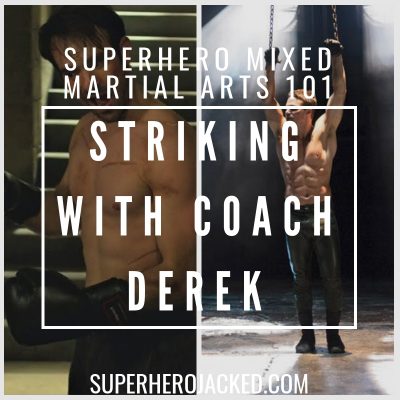Last updated on January 6th, 2020 at 12:26 am
 So let’s start by saying you were amazed at what you just saw Charlie Cox or Stephen Amell do and want to learn how to do that.
So let’s start by saying you were amazed at what you just saw Charlie Cox or Stephen Amell do and want to learn how to do that.
You could be an action aficionado and want to emulate that move you just saw your hero do.
Were you inspired by the training montage in your favorite sports film?
Watched the latest MMA or boxing match and said, “I want to do that”?
It is also possible it’s none of the above and you just want to hit the bag to get in better shape.
You got your gloves on…now standing in front of the bag thinking “Now what?”…
Well I’m here to drop a truth bomb on you true believers when I tell you THE SCIENCE OF STRIKING CAN NOT BE SELF TAUGHT.
The best way to learn is with a real life coach or instructor.
It’s the best and true way to really learn the little details; and believe me, there’s tons of them.
When I say experienced I mean it, I’m not talking getting together with your buddies thinking you can do it in your garage and you have experience (If this were the case I could claim I have WWE experience by doing choke slams, Rock Bottoms and Stone Cold Stunners with my nephew on his trampoline)!
Sure there’s a plethora of information out there and tons of videos to reference. I myself am subscribed to tons of boxing, MMA, BJJ and Thai sites and when I receive new videos of a technique I want to try, I always try it with one of MY coaches or a fellow instructor.
There’s what we think, what we know, and what we can prove.
Each technique works differently per individual.
I’m also going to dispel a notion we have heard all our lives “Practice makes perfect”.
This couldn’t be further from the truth when it comes to mixed martial arts and self defense.
Proper technique is proper technique, whether you are lifting or striking. If you do it incorrectly 100 times, it’s still being done incorrectly.
PRACTICE CREATES HABITS. Get it? Got it? Good!
People play baseball, basketball, football and hockey. Nobody plays MMA or boxing.
But fear not I am here to assist you with some fundamentals so when you do decide to take that step, you wont feel so lost or intimidated or feel like a deer in the headlights when you are asked by a coach.
Lets start with stances and balance.
This is your foundation. Remember the nose, knee and toe rule for balance.
It should be a ladder. If your knee goes past your toe and your nose goes over your knee, your balance is compromised.
Basic Boxing Stance
If you’re a righty, your left shoulder should always facing the opponent (and vice versa). Stand with legs shoulder-width apart, knees slightly bent, left foot turned to point toward your opponent. Make loose fists, and hold your hands by your chin, left hand down in front of your face. Chin down, eyes up, elbows down.
The Gospel in boxing and Muay Thai is that the hand you’re not using is protecting your face at all times.
Muay Thai Stance
For a Muay Thai posture from which to both attack and defend, start by standing with your feet shoulder width apart. Depending on which is your strong side, you’ll want to step that leg back, i.e. if you’re right handed, right leg takes a step back, left leg stays forwards.
Make sure that you don’t turn sideways, keep both your hips facing forwards.
Place both hands up in front of the face at about eye level.
This is called your guard.
Behind that make sure to tuck your chin downwards, this will protect it from incoming strikes. This is the position you throw all your strikes from, and whenever you throw any strike, you will return to this position, ready to defend.
A variation of this tighter guard is the long guard, a hand position commonly found in Muay Thai. Instead of keeping both hands close to the face, you can extend them a little towards the opponent, almost as if reaching towards them. Your lead hand should extend a little further towards your opponent, creating something of a frame between you.
Punching Basics (4 combo) *from either stance*
Sources of power:
Locomotion
Rotation
Inclination
Power comes from the hips (not just the arms). Don’t keep your head in the same spot when striking as you are an easy target for counters. Always exhale upon impact (even when shadowboxing) with a hissing sound.
Jab (aka 1.) Source of power: locomotion
From starting position, punch with your lead hand, twisting your hand so that your knuckles are up, palm down, when you connect. Snap the movement at the end, and bring the arm back into the starting position to protect your face. Take a small step forward with your right foot as you jab, (or vise versa if you are a lefty) and pivot on the ball of your front foot.
Cross (aka 2) Source of power: locomotion
From starting position, keep your front foot grounded and pivot on the back foot, turning your torso toward your opponent. As you punch, twist your hand again like you did with the jab (knuckles up, palm down). After you connect, snap your arm back to your chin, don’t cycle it.
Hook (aka 3) Source of power: rotation
From your starting stance lift your leading arm up to nose height so it forms a right angle in front of you. In the same motion, pivot your feet and turn your torso which will put force behind your hook and move your punching motion to the right. Don’t wind up the arm. You should be using the power in your legs and body to throw the hook. Remember to keep your other hand up by your face.
Uppercut (aka 4) Source of power: inclination
Bend your knees slightly, and turn just a tad toward your target. With your dominant hand, punch straight up from the chin. Don’t wind up. Use your knee bend to put some power behind it, and just drive straight up. Make sure to keep the opposite hand by your face

Kicking Fundamentals
Roundhouse Leg Kick Principles (Loaded vs Unloaded) For Muay Thai and MMA
Loaded leg hurts less because muscles are activated, but is harder to defend.
Unloaded leg hurts more because muscles are loose, but easier for opponent to raise up and shield.
Keep your knees bent even after kicks to protect knee; as a straight leg is very easy to damage with kicks.
Be Specific with targets:
When kicking outside of leg target the common personal nerve (where quad meets the knee), and also target the sciatic nerve (located at the split between the quad & hamstrings).
When kicking to the inside of the leg, aim for the femoral nerve and the tibial nerve.
Always remember to point your front toe towards the chin of your opponent. If your leg is turned in, it’s much more vulnerable to kicks and sweeps. HIT WITH YOUR SHIN, pivot and open your hips.
Drills (one for one leg kicks)
- Jab, Cross, Right leg kick
- Jab, Cross , Hook (causing opponents weight onto lead leg), Right leg kick
- Jab and step outside ( at the same time ) , Outside Cut kick
- Leg Kick while opponent advances (makes shielding more difficult for opponent)
- Return Fire , when opponent throws a body kick , return fire by throwing an inside cut kick to his kicking leg Quad as they place it back to the ground. Another option is to return fire to the back of their lead leg as opponent’s back leg places on the ground
Once you get more comfortable you can use these in your shadowboxing or heavy bag sessions and build on it.
Please note and understand, drilling these basics DOES NOT mean you can fight or defend yourself.
Proper way of doing so takes YEARS of drilling & practice. I’ve been in the game for almost 20 years and I’m STILL learning (Yes, I still have coaches and teachers too).
Hopefully this article assisted in a better understanding to a whole new exciting venue for you.
Enjoy!
######
Coach Derek
SHJ’s Iron Man

SUPERHUMAN SECRETS V.2
NOW UPDATED AND EXPANDED WITH A NEW SECTION & SEVEN BONUSES
USD$29 USD$14.95

USD$29 USD$7.95
UNLOCK THE SECRETS TO UNLEASHING YOUR INNER SUPERHUMAN

GRAB THE UNOFFICIAL ABSOLUTE BEST ANIME CALISTHENICS WORKOUT BOOKLET!
Over a Dozen of The Top Anime Inspired Calisthenics/Bodyweight Workouts from The SHJ Databases based on Your Favorite Characters from A Wide Variety of Fandoms and Themes
(Unofficial Workouts Inspired by Characters)

